6 Types of Cockroaches We Encounter Everyday

Out of the 450 cockroaches scurrying around our homes, offices and gardens, only a few really make an impact on our lives. We’ve identified the dirty half dozen, the top six roaches that you’re most likely to encounter in your kitchen, behind your furniture or in your walls. Although the German cockroach, Australian cockroach and American cockroach are the most common, being able to identify the correct cockroach species on sight will help you address any infestation issues efficiently – every species has its quirks. Learn more about the appearance, habits and habitat of Australia’s most notorious pests below.
Cockroach Profiles
Australian Cockroach

Periplaneta australasiae
Appearance: Pronounced yellow halo around the pronotum (area adjoing the head), with a dark reddist hue to exoskeleton. Winged roaches with light markings on throat. Prefer to move around at night.
Size: 30-35mm long
Habitat: Outdoors – tress, woodpiles and environments with lots of decaying plants. Indoors – cupboards, drawers, kitchens, garages, walls and rood voids.
Lifecycle: Egg casings contain up to 24 eggs and females may produce 12-30 egg capsules between adulthood and death. Australian roaches reach maturity after 12 months and die around 8 months later.
Food: The Aussie roach loves decaying vegetables and plants, in addition to starchy materials like book bindings.
American Cockroach
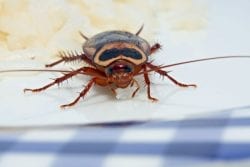
Periplaneta americana
Appearance: The American cockroach are remarkably good at gliding. Spot one by looking at for a reddish brown colour and yellow border near the head, although nowhere as defined as the Australian cockroach. American cockroches are also rangers, leaving their breeding nests to find food in far off places.
Size: 35-40mm long
Habitat: American roaches hate light and thrive in humid environments. They’re commonly found indoors, including houses and apartments, restuarants and hospitals, containers ships, sewers and roof voids. You may find them outdoors in warmer areas.
Lifecycle: Egg capsules contain 12-16 eggs and take 38-55 days to hatch. Females may produce 6-90 egg capsules before they die. Adults roaches can live up to 2 years following the nymphal (juvenile) phase.
Food: Adult American roaches can survive 1 month without any food or water, or 2-3 months without food. They eat decaying organics, book binds, paper, clothes and sweet things.
German Cockroach
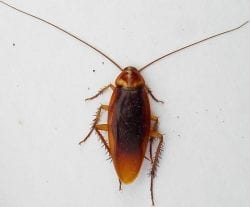
Blatella germanica
Appearance: You’ll instantly recognise a German cockroach by its 2 darkly coloured stripes near their head. Every home and business has at least one German cockroach, due to their dense distribution.
Size: 12-15mm long
Habitat: German roaches prefer indoor living, specifically kitchens and bathrooms – commercial and residential buildings both appeal to the German cockroach, as long as conditions are wet and humid.
Lifecycle: Female German roaches carry their egg casings around, until the 35-40 eggs within are ready to hatch 30 days later. Juveniles grow fast, reaching maturity anywhere between 6 weeks to 6 months. German cockroaches are capable of producing 3-4 generations annually.
Food: Decaying organic matter
Oriental Cockroach
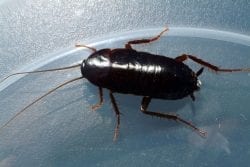
Blatta orientalis
Appearance: Dark brown to black in hue, with poorly developed wings in females. Oriental cockroaches prefer to run opposed to fly.
Size: 20-25mm long
Habitat: Extremely adaptable, you’ll find Oriental roaches in damp environments like drains, beneath patios and porches or basements in commercial buildings. They also thrive in a cool, natural setting.
Lifecycle: Female Oriental cockroaches produce egg casings containing 16 eggs that take around 2 months to hatch. Juveniles won’t reach adulthood for 6-18 months, with adult expectancy is anywhere between 35 and 180 days.
Food: Oriental roaches are dumpster divers, feeding on garbage and leaf litter.
Brown Banded Cockroach
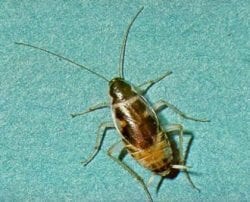
Supella longipalpa
Appearance: The micro machines of the cockroach world, the Brown Banded cockroach are identified by the yellow/brown stripes across their body. They can fly, but only do so in very warm weather.
Size: 10-15mm long
Habitat: They’re attracted to heated buildings and appliances, hiding out inside ceilings and fridge motors. They rarely come out in the daytime, saving their activity for night.
Lifecycle: Female Brown Banded roaches are responsible for around 14 egg capsules in a lifetime, with each containing 10-18 eggs. They mature quickly depending on conditions, reaching adulthood in 90 days, provided the conditions are good. An adult brown-banded cockroach only lives between 130 to 315 days.
Food: Brown Banded roaches will eat almost anything, although they enjoy book bindings and other starchy materials the most.
Smoky Brown Cockroach
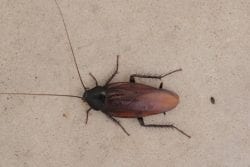
Appearance: The Smoky Brown roach prefers to stay on the ground, but can fly in very warm conditions, using wings that either overlap the body (male) or those that only cover the abdomen (female). They are always dark brown in colour.
Size: 3-35mm
Habitat: Zeroes in on hollow and obscured areas, like tree hollows and under floors, using the cover of night to enter buildings. Commonly hides in any dark, warm place during the day, avoiding human contact.
Lifecycle: Female Smoky Brown roaches attaches an egg casing containing 22-26 eggs to a dark corner to hatch. Females can deposit 32 oothecae (egg cases) in a single life cycle. Juveniles take around 6-12 months to develop into adults. Once they’ve achieved maturity, females live 218 days on average, while males last around 215.
Food: Everything. They eat sweets, meats, other dead insects, starchy materials and even faecal matter.
We have a simple mission. To rid your home of pests, creepies, crawlies and insects you’d rather see the back of forever. Don’t let the roaches win – contact Canberra Pest Control today and book a result guaranteed pest spray today!